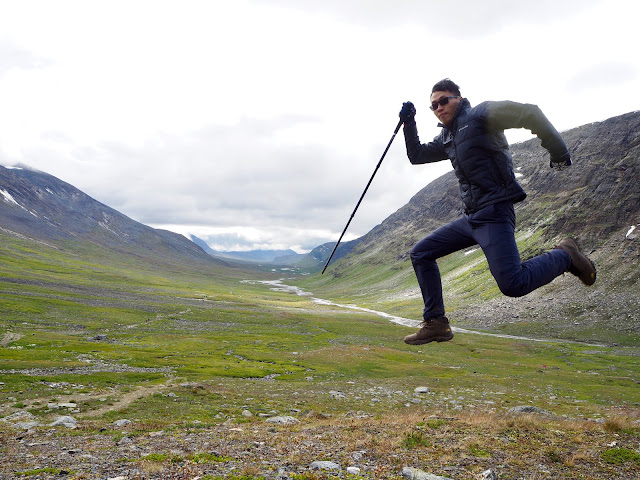After a late night and a long hike the day before, we woke up at about 6.30am again, and left past 9am this time due to the inconvenience of the lack of a stream nearby and having to walk to the station for the water tank.
The trail follows along a lake, but the lake is NOT drinkable. It's considered a stale water body since the water collects in the lake, even though you'll see that the water is moving due to the wind. The trail from Alesjaure to Kieron has a dry portion in the second half, so you'll need to fill your bottle wherever possible. You can use the map given to look out for when the streams end.
One of the bigger streams after the Alesjaure station where you can refill your bottle. You also have to cross this stream.
The trail is mostly walking through shrubs on a wooden platform and the lake would be on your right for most of the trail. We knew that we only had 18km to cover that day, so we took it easy. After about halfway, we stopped for lunch at some rocks overlooking the lake. The view was spectacular, also because the sun was out at that time.
Where we stopped for lunch
We met our German friends while having lunch!
After the shrubs ended, the trail opened up to fields where reindeers could roam free (but we didn't see any, probably because there were too many people on the trail and it's not winter). We took a short break at 12km, which was the start of many problems later in the day. It started to drizzle after that short break and the drizzle became heavier. We were caught in that rain and by the time we got to Kieron, which comprised of a very steep down slope with wet mud due to the rain, we were completely soaked.
The steep descent with mud
The Kieron checkpoint is right after a huge river crossing with a bridge, which is the only place where you can refill water in the surrounding area. I highly suggest you refill your bottles here before heading to the checkpoint. It'll save you quite a bit of walking later on.
At Kieron, the sun came back out and there were pancakes served! We had 2 rounds of pancakes (we were lucky, because they were actually controlling the pancake servings but we went when the volunteers changed shifts).
As a result of eating our 2 rounds of pancakes, we did not set up our tent when the sun was out. The weather changed to a sudden torrential downpour and we just stood there for a good half hour to an hour at least, shivering in the cold rain. We used our umbrellas and drank hot tea, which helped a bit but it was probably one of the most horrible experiences in my life.
When the rain lightened up slightly, we hurried and pitched our tent, but by that time we were all wet and dirty and our clothes were all soaked through because we learnt that our jackets were not waterproof enough. Neither of our pants is waterproof, so they were soaked as well. Our socks and the inside of our boots got soaked since the water from our pants dripped in and collected there. The worst part was that we placed our bags on some rocks, which were wet from the rain. Since our bags had other attachments on them, our rain covers did not stretch to the bottom. Hence, the water seeped in from the bottom of our bags. Though they were G-1000, the rain was simply too heavy. This resulted in our sleeping bags getting wet since they were at the bottom. A ton of other things were wet too, but they were thankfully in ziplock bags. We didn't eat dinner that night (at least we had 6 pancakes each) but just wiped down and dried ourselves and slept at 8pm. Since we didn't have our sleeping bags, we were way too cold and woke up every 1.5 hours or so, and even had to light the gas stove in our tent to warm up the place.
I think this night was rather memorable and we definitely learnt that we need better waterproof clothing, as well as to set up the tent whenever the sun is out!
Total distance covered on Day 4: 18.15km
Read more about the Fjällräven Classic Sweden:
General Guide
Check in
Day 1
Day 2
Day 3
Day 5
















































